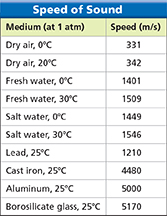17.4 Sound and Hearing
Reading Focus
Key Concepts
 What properties explain the behavior of sound?
What properties explain the behavior of sound? How is ultrasound used?
How is ultrasound used? How does frequency of sound change for a moving source?
How does frequency of sound change for a moving source? What are the functions of the three main regions of the ear?
What are the functions of the three main regions of the ear? How is sound recorded?
How is sound recorded? How do musical instruments vary pitch?
How do musical instruments vary pitch?
Vocabulary
sound waves
intensity
decibel
loudness
pitch
sonar
Doppler effect
resonance
Reading Strategy
Using Prior Knowledge Copy the web diagram below. Before you read, add properties you already know about. Then add details about each property as you read.

Take a moment to listen. Even in a quiet room you can usually hear many different sounds. You might hear someone opening a book, people talking in the hall, cars and trucks driving outside, and maybe even an airplane flying overhead. You can identify sounds without seeing them because sound waves carry information to your ears.
Properties of Sound Waves
Sound waves are longitudinal waves—compressions and rarefactions that travel through a medium. Have you ever stopped to question why sounds can hurt your ears? Why there is a delay before you hear an echo down a long, empty hallway at school?  Many behaviors of sound can be explained using a few properties—speed, intensity and loudness, and frequency and pitch.
Many behaviors of sound can be explained using a few properties—speed, intensity and loudness, and frequency and pitch.
Figure 14 The speed of sound is shown here for a variety of materials.
Making Generalizations How does temperature affect the speed of sound?
 dd
ddSpeed
Why is there a delay when you hear an echo? It takes time for sound to travel from place to place. In dry air at 20°C, the speed of sound is 342 meters per second. That's more than ten times faster than your speed in a car on a highway!
Figure 14 shows how the speed of sound varies in different media. In general, sound waves travel fastest in solids, slower in liquids, and slowest in gases. This is partly due to the fact that particles in a solid tend to be closer together than particles in a liquid or a gas. The speed of sound depends on many factors, including the density of the medium and how elastic the medium is.




